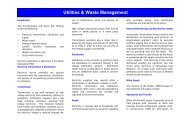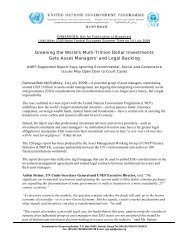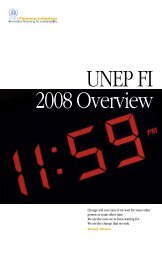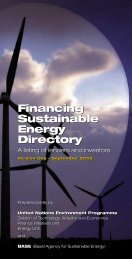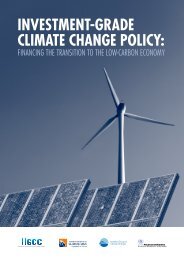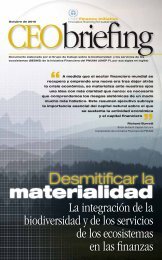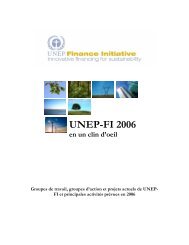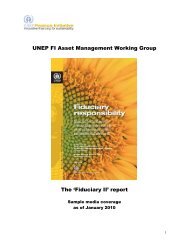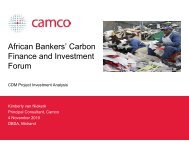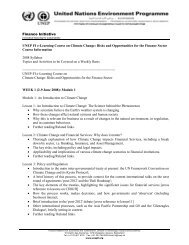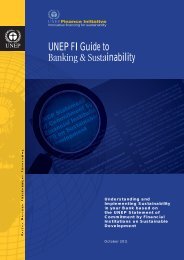for Business - TEEB
for Business - TEEB
for Business - TEEB
You also want an ePaper? Increase the reach of your titles
YUMPU automatically turns print PDFs into web optimized ePapers that Google loves.
6. BUSINESS IS FINDING NEW WAYS TO REDUCE<br />
BIODIVERSITY AND ECOSYSTEM RISKS<br />
Public acceptance of biodiversity loss is declining,<br />
leading to calls <strong>for</strong> low-impact production<br />
and compensation <strong>for</strong> impacts on biodiversity<br />
and ecosystems 38 . Many companies are exploring<br />
how to manage the adverse impacts of their activities<br />
on BES. A few companies have made public commitments<br />
to ‘No Net Loss’, ‘Ecological Neutrality’ or even<br />
‘Net Positive Impact’ on biodiversity, or on specific<br />
ecosystem services such as water resources (see<br />
Chapter 4 in the <strong>TEEB</strong> <strong>for</strong> <strong>Business</strong> report). In some<br />
cases, even relatively straight-<strong>for</strong>ward ecological<br />
restoration following resource extraction can deliver<br />
biodiversity benefits that may exceed those of the<br />
original land use (Box 6).<br />
Managing biodiversity risk involves looking<br />
beyond sites and products to the wider land and<br />
seascape. In the mining and oil and gas industries,<br />
<strong>for</strong> example, corporate environmental risk management<br />
has tended to focus on direct or primary impacts<br />
– those that result from site-level activities which could<br />
be avoided or mitigated through improved processes,<br />
procedures or technologies 40 . However, increasing public<br />
scrutiny and more stringent regulations have led<br />
companies across a range of sectors to extend their<br />
risk horizon to include indirect or secondary impacts.<br />
This is echoed by growing interest in landscape level<br />
assessment and planning tools, product life cycle analysis<br />
and supply chain management, based on environmental<br />
criteria (Chapter 4).<br />
Effective biodiversity and ecosystem risk management<br />
may be facilitated by appropriate enabling<br />
frameworks and partnerships. These may<br />
include new markets <strong>for</strong> biodiversity-friendly products,<br />
investment screening processes that require attention<br />
to biodiversity impacts, and/or regulatory settings that<br />
pay close attention to biodiversity risks during the impact<br />
assessment process (Chapter 4). <strong>Business</strong> risk<br />
management strategies also often involve public-private<br />
partnerships and stakeholder engagement 41 .<br />
Box 6: Valuing the benefits of wetland restoration: Aggregate Industries UK<br />
In support of a request to extend an existing quarry in North Yorkshire, Aggregate Industries UK (a<br />
subsidiary of Holcim) proposed to create a mix of wetlands <strong>for</strong> wildlife habitat as well as a lake <strong>for</strong><br />
recreational use, following extraction of sand and gravel from land currently used <strong>for</strong> agriculture.<br />
Stakeholders were consulted to determine their preferences. Ecosystem valuation was undertaken in<br />
2009-10 to estimate the benefits associated with wetland restoration. Using a 50 year time horizon<br />
and a 3% discount rate, the study concluded that the value of biodiversity benefits generated by the<br />
proposed wetlands (US$ 2.6 million in 2008), the recreational benefits of the lake (US$ 663,000) and<br />
increased flood storage capacity (US$ 417,000) would, after deducting restoration and opportunity<br />
costs, deliver net benefits to the local community of about US$ 2 million, in present value terms.<br />
Moreover, the marginal benefits of wetland restoration far exceeded the current benefits derived from<br />
agricultural production. The study further shows that the costs of ecosystem restoration and aftercare<br />
are low compared to both the economic benefits of wetland restoration and the financial returns from<br />
sand and gravel extraction.<br />
Source: Olsen with Shannon (2010) 39<br />
T E E B F O R B U S I N E S S – E X E C U T I V E S U M M A R Y 9



